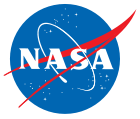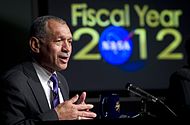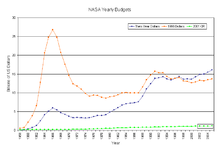- Budget of NASA
-
National Aeronautics and Space Administration 
NASA insignia Agency overview Formed July 29, 1958 Annual budget $18.724 billion (Fiscal Year 2011)[1] Each year, the United States Congress passes a Federal Budget detailing where federal tax money will be spent in the coming fiscal year.
The following charts detail the amount of federal funding allotted to the National Aeronautics and Space Administration (NASA) each year over its past fifty year history (1958–2008) to operate aeronautics research, unmanned planetary and manned space exploration programs.
Contents
Annual budget, 1958-2010
Seen in the year-by-year breakdown listed below, the total amounts (in nominal dollars) that NASA has been budgeted from 1958 to 2008 amounts to $471.23 billion dollars—an average of $9.06 billion per year. By way of comparison, total spending over this period by the National Science Foundation was roughly one-fourth of NASA's expenditures: $101.5 billion, or $2 billion a year.[2] NASA's FY 2008 budget of $17.318 billion represents about 0.6% of the $2.9 trillion United States federal budget during the year, or about 35% of total spending on academic scientific research in the United States.[3]
According to the Office of Management and Budget and the Air Force Almanac, when measured in real terms (adjusted for inflation), the figure is $790.0 billion, or an average of $15.818 billion dollars per year over its fifty year history (NASA's 2011 budget is on a continuing resolution of the 2010 budget at $18.724 billion).[citation needed]
History of NASA's annual budget (millions of US dollars)
Year NASA budget (Nominal) % of Fed Budget[4][5] 2007 Constant
Dollars1958 89 0.1% 488 1959 145 0.2% 1,841 1960 401 0.5% 3,205 1961 744 0.9% 6,360 1962 1,257 1.18% 12,221 1963 2,552 2.29% 24,342 1964 4,171 3.52% 33,241 1965 5,092 4.31% 33,514 1966 5,933 4.41% 32,106 1967 5,425 3.45% 29,696 1968 4,722 2.65% 26,139 1969 4,251 2.31% 21,376 1970 3,752 1.92% 18,768 1971 3,382 1.61% 15,717 1972 3,423 1.48% 15,082 1973 3,312 1.35% 14,303 1974 3,255 1.21% 11,494 1975 3,269 0.98% 11,131 1976 3,671 0.99% 11,640 1977 4.002 0.98% 11,658 1978 4,164 0.91% 11,411 1979 4,380 0.87% 11,404 1980 4,959 0.84% 11,668 1981 5,537 0.82% 11,248 1982 6,155 0.83% 11,766 1983 6,853 0.85% 13,051 1984 7,055 0.83% 13,561 1985 7,251 0.77% 13,218 1986 7,403 0.75% 13,421 Year NASA budget (Nominal) % of Fed Budget[4][5] 2007 Constant
Dollars1987 7,591 0.76% 17,735 1988 9,092 0.85% 14,454 1989 11,036 0.96% 16,734 1990 12,429 0.99% 18,019 1991 13,878 1.05% 19,686 1992 13,961 1.01% 15,310 1993 14,305 1.01% 18,582 1994 13,695 0.94% 18,053 1995 13,378 0.88% 16,915 1996 13,881 0.89% 16,457 1997 14,360 0.90% 15,943 1998 14,194 0.86% 15,521 1999 13,636 0.80% 15,357 2000 13,428 0.75% 14,926 2001 14,095 0.76% 15,427 2002 14,405 0.72% 15,831 2003 14,610 0.68% 16,021 2004 15,152 0.66% 15,559 2005 15,602 0.63% 16,016 2006 15,125 0.57% 16,085 2007 15,861 0.58% 15,861 2008 17,318 0.60% 17,138 2009 [6] 17,782 2010 [6] 18,724 2011 [6] 19,000 2012 (est.) [6] 19,450 2013 (est.) [6] 19,960 2014 (est.) [6] 20,600 2015 (est.) [6] 20,990 Notes: Sources: U.S. Office of Management and Budget (OMB) (needs proper citation-link, numbers here differ from NASA Pocket Statistics),
Air Force Association's Air Force Magazine 2007 Space Almanac
Secondary references: [1] [2] [3]Cost of project Apollo
NASA's budget peaked in the period 1964-1966, during the height of construction efforts leading up to the first moon landing under Project Apollo which involved more than 34,000 NASA employees and 375,000 employees of industrial and university contractors. Roughly 4% of the total federal budget was being devoted to the space program.
In March 1966, NASA officials briefing Congressional members stated the "run-out cost" of the Apollo program, aimed at achieving a manned lunar landing, would be an estimated $22.718 billion for the 13-year program, which had begun in 1959. According to Steve Garber,[citation needed] the NASA History website curator, the final cost of project Apollo was between $20 and $25.4 billion in 1969 Dollars (or approximately $136 billion in 2007 Dollars). The costs associated with the Apollo spacecraft and Saturn rockets amounted to about $83-billion in 2005 Dollars (Apollo spacecraft cost $28-billion (Command/Service Module $17-billion; Lunar Module $11-billion), Saturn I, Saturn IB, Saturn V costs about $ 46-billion 2005 dollars).
Economic impact of NASA funding
A November 1971 study of NASA released by the Midwest Research Institute of Kansas City, Missouri ("Technological Progress and Commercialization of Communications Satellites." In: "Economic Impact of Stimulated Technological Activity") concluded that “the $25 billion in 1958 dollars spent on civilian space R & D during the 1958-1969 period has returned $52 billion through 1971 -- and will continue to produce pay offs through 1987, at which time the total pay off will have been $181 billion. The discounted rate of return for this investment will have been 33 percent.”
A 1992 article in the British science journal Nature reported:[7]
"The economic benefits of NASA's programs are greater than generally realized. The main beneficiaries (the American public) may not even realize the source of their good fortune. . ."
Other statistics on NASA's economic impact may be found in the 1976 Chase Econometrics Associates, Inc. reports ("The Economic Impact of NASA R&D Spending: Preliminary Executive Summary.", April 1975. Also: "Relative Impact of NASA Expenditure on the Economy.", March 18, 1975) and backed by the 1989 Chapman Research report, which examined 259 non-space applications of NASA technology during an eight year period (1976–1984) and found more than:
— $21.6 billion in sales and benefits;
— 352,000 (mostly skilled) jobs created or saved,and;
— $355 million in federal corporate income taxes
According to the "Nature" article, these 259 applications represent ". . .only 1% of an estimated 25,000 to 30,000 Space program spin-offs."
In 2002, the aerospace industry accounted for $95 billion of economic activity in the United States, including $23.5 billion in employee earnings dispersed among some 576,000 employees (source: Federal Aviation Administration, March 2004).
Public perception
The American public perceives the NASA budget as commanding a much larger share of the federal budget than it in fact does. A 1997 poll reported that Americans had an average estimate of 20% for NASA's share of the federal budget, far higher than the actual 0.5% to under 1% that has been maintained throughout the late 90's and first decade of the 2000s.[8]
Related legislation
- 1961— Apollo mission funding PL 87-98 A
- 1970— National Aeronautics and Space Administration Research and Development Act, PL 91-119
- 1984— National Aeronautics and Space Administration Authorization Act, PL 98-361
- 1988— National Aeronautics and Space Administration Authorization Act, PL 100-685
- 2005— National Aeronautics and Space Administration Authorization Act of 2005, PL 109-155[9]
- 2010— National Aeronautics and Space Administration Authorization Act of 2010
See also
- Space policy of the United States
- Federal budget (United States)
- Budget
- Space exploration
- Vision for Space Exploration
References
- ^ Bill Summary of NASA Authorization Act of 2010
- ^ "Budget Internet Information System". National Science Foundation. http://dellweb.bfa.nsf.gov/. Retrieved 2009-01-12.
- ^ "Federal Spending on Academic Research Continued Downward Trend in 2007". August 25, 2008. http://chronicle.com/news/article/5055/federal-spending-on-academic-research-continued-downward-trend-in-2007. Retrieved 2009-01-13.
- ^ a b % of total federal expenditures from: http://www.guardian.co.uk/news/datablog/2010/feb/01/nasa-budgets-us-spending-space-travel
- ^ a b 1999-2010 based on federal outlays from: Federal_budget_(United_States)#Total_outlays_in_recent_budget_submissions
- ^ a b c d e f g 2011 Budget Overview
- ^ Roger H. Bezdek & Robert M. Wendling (January 9, 1992). "Sharing out NASA's spoils". Nature (Nature Publishing Group) 355 (6356): 105–106. Bibcode 1992Natur.355..105B. doi:10.1038/355105a0. http://www.nature.com/nature/journal/v355/n6356/pdf/355105a0.pdf. Retrieved 2008-03-30. "The economic benefits of NASA's programmes are greater than generally recognized. The main beneficiaries may not even realize the source of their good fortune."
- ^ Launius, Roger D.. "Public opinion polls and perceptions of US human spaceflight". Division of Space History, National Air and Space Museum, Smithsonian Institution. http://si.academia.edu/documents/0011/5660/Public_Opinion_Polls_and_Perceptions_of_US_Human_Spaceflight.pdf.
- ^ National Aeronautics and Space Administration Authorization Act of 2005, PL 109-155, US Government, December 30, 2005.
- Inflation Index
- Budget of the United States Government, Fiscal Year 2009
- Budget of the United States Government, Fiscal Year 2008 (download 08msr.pdf, see Table S-10)
- The National Debt in FY 2007 - $406 Billion spent on interest payments compared to NASA at $16 Billion, Education at $61 Billion, and Department of Transportation at $56 Billion.
- Medicare, Medicaid, State Children's Health Insurance Program information
- White House Office of Management Budget FY 2008
- U.S. Census Clock
- American Association for the Advancement of Science (Research and Development programs budget extract)
- "NASA chief set to cut projects" Orlando Sentinel - Apr. 6, 2007
- "NASA budget $550M less than hoped" Florida Today - Feb. 15, 2007
- "NASA, other agencies denied pay raise" MSNBC and Space.com - Feb. 15, 2007
- "JPL faces program cuts with fewer NASA funds" Pasadena Star News - Feb. 7, 2007
- "NASA Spending Plan Reflects White House Policy" Space News/Space.com - Feb. 5, 2007
- "Highlights of NASA's FY 2008 Budget Request" Remarks by NASA Administrator Michael D. Griffin's during Feb. 5, 2007 press conference at NASA Headquarters
- "NASA's FY 2008 Budget Full Report (4.2Mb PDF) - Feb. 5, 2007
- "NASA's FY 2008 Budget" Budget Summary (710Kb PDF) - Feb. 5, 2007
- "NASA FY 2008 Budget" Presentation Chart (743 Kb PDF) - Feb. 5, 2007
- "Congress may trim NASA budget" Florida Today - Feb. 4, 2007
- "Should NASA be a spending priority?" The Position Page: The Blog of the Orlando Sentinel Editorial Board - Feb. 2, 2007
- "Coalition for Space Exploration Statement Regarding U.S. House of Representatives Budget Proposal" SpaceRef.com - Feb. 1, 2007
- "NASA faces budget cutbacks" Florida Today - Feb. 1, 2007
- "House budget proposal could delay shuttle replacement" Space News/Space.com - Jan. 31, 2007
- "NASA announces FY 08 budget press conference" NASA Media Advisory #M07-014 - Jan. 30, 2007
- "Planetary Society petitions President to save space science" SpaceRef.com - Jan. 22, 2007
- "IFPTE Calls for Balanced and Transparent NASA Budget Preserving Science & Aero, Core Technical Capabilities Achievable Within FY06 baseline" SpaceRef.com - Jan. 2, 2007
- NASA's portion of the Budget of the United States Government, FY 2007 Office of Management and Budget Report
- NASA 2006 Strategic Plan
- NASA 2006 Pocket Statistics
- NASA FY2006 Budget breakdown
- NASA FY2006 Performance and Accountability Report
- H.R. 3070 - National Aeronautics and Space Administration Authorization Act of 2005 (from Congressional Budget Office, July 20, 2005 - Cost estimate for the bill as reported by the House Committee on Science on July 18, 2005)
- NASA Previous Years (FY2005, FY2004 and FY2003) Performance and Accountability Reports
- NASA FY2003 and Previous Years' Budget
- NASA Strategy based on long-term affordability Budget Chart - Jan. 14, 2004
- Midwest Research Institute homepage
External links
- Table 1 -- NASA's budget compared to other federal government expenditures (1999 Data)
- Table 2 -- NASA's budget compared to various consumer expenditures (1997 Data)
- Table 3 -- NASA's budget compared to the budgets of the 50 state governments (1997 Data)
- Table 4 -- NASA's budget compared to revenues of various large corporations (1998 Data)
- NASA - Budget Documents, Strategic Plans and Performance Reports (NASA - Budget Information)
Categories:- United States federal budgets
- NASA oversight
Wikimedia Foundation. 2010.




